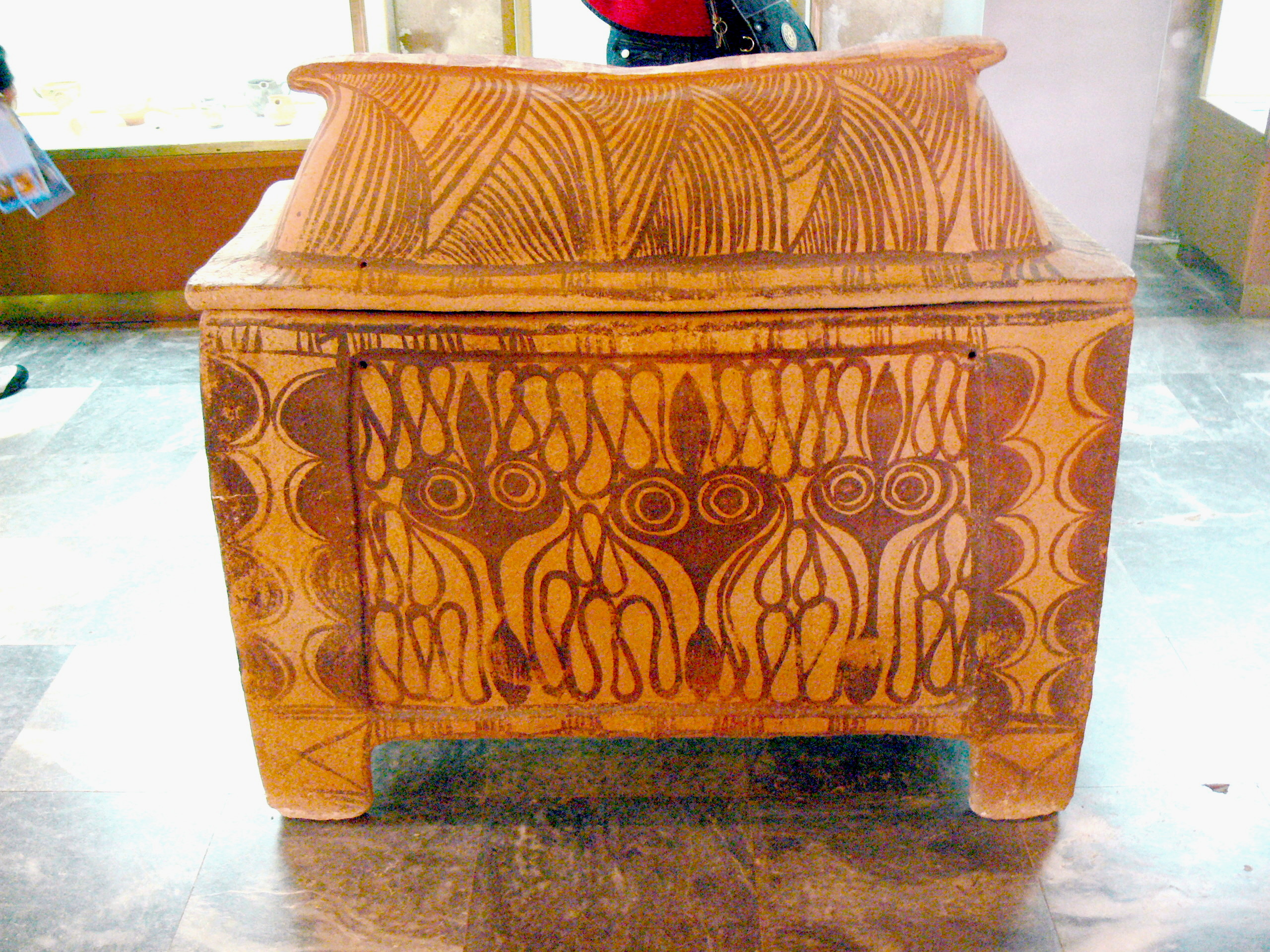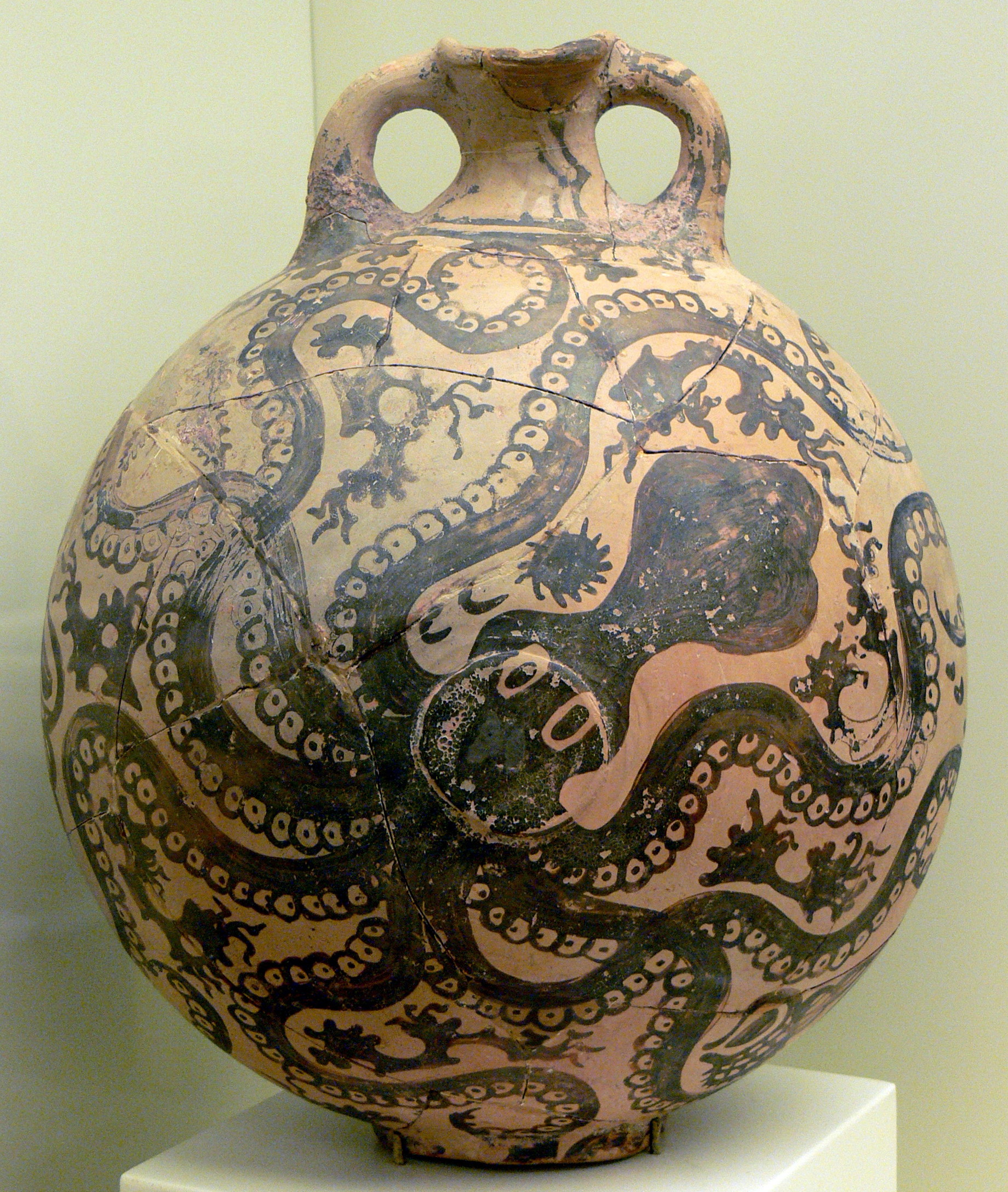|
Armeni (archaeological Site)
Armeni is the archaeological site of an ancient Minoan cemetery on Crete, roughly eight kilometers south of the modern town of Rethymnon. Site Armeni has been under excavation since 1969 by Dr. Yiannis Tzedakis. Over 200 chamber tombs and one tholos tomb have been found. All date to the Late Minoan era. The chambers are approached by entrance passages, or dromos, which start at ground level and descend to the entrance of the tomb. The tombs are not identical, with some having ramps while others have stairs. The walls of the dromos have been cut in such a way that they are closer to each other at the top than they are at the bottom, probably to help bear the weight of the earth above. The entrances were originally covered by a large stone, which is usually still next to the entrance. Several of the larger tombs have a pillar in the center of the chamber. One tomb's walls are lined with stone benches cut directly from the rock. Artifacts Artifacts from the chamber tombs includ ... [...More Info...] [...Related Items...] OR: [Wikipedia] [Google] [Baidu] |
AMC - Sarkophag Armeni 3
AMC may refer to: Film and television * AMC Theatres, an American movie theater chain * AMC Networks, an American entertainment company ** AMC (TV channel) ** AMC+, streaming service ** AMC Networks International, an entertainment company *** AMC (Asian TV channel), TV channel *** AMC (European TV channel), TV channel *** AMC (African and Middle Eastern TV channel), TV channel Other * Australian Multiplex Cinemas * '' All My Children'', a TV series Education * Academia Mexicana de Ciencias, a Mexican education organization * American Mathematics Competitions * Andhra Medical College, Andhra Pradesh, India * Archif Menywod Cymru, Welsh organisation also known as Women's Archive Wales * Army Medical College, Punjab, Pakistan * Australian Maritime College, Launceston, Tasmania * Australian Mathematics Competition * Ayub Medical College, Khyber-Pakhtunkhwa, Pakistan * AMC Institutions, Bangalore, India Finance * Ameriquest Mortgage Company * Association management company * ... [...More Info...] [...Related Items...] OR: [Wikipedia] [Google] [Baidu] |
Larnakes
A larnax (plural: larnakes; grc, λάρναξ, ''lárnaks'', plural: , ''lárnakes'') is a type of small closed coffin, box or "ash-chest" often used in the Minoan civilization and in Ancient Greece as a container for human remains—either a corpse (bent back on itself) or cremated ashes. The first larnakes appeared in the Minoan period of the Aegean civilization, when they took the form of ceramic coffers designed to imitate wooden chests, perhaps on the pattern of Egyptian linen chests. They were richly decorated with abstract patterns, octopuses and scenes of hunting and cult rituals. [...More Info...] [...Related Items...] OR: [Wikipedia] [Google] [Baidu] |
Minoan Sites In Crete
The Minoan civilization was a Bronze Age Aegean civilization on the island of Crete and other Aegean Islands, whose earliest beginnings were from 3500BC, with the complex urban civilization beginning around 2000BC, and then declining from 1450BC until it ended around 1100BC, during the early Greek Dark Ages, part of a wider bronze age collapse around the Mediterranean. It represents the first advanced civilization in Europe, leaving behind a number of massive building complexes, sophisticated art, and writing systems. Its economy benefited from a network of trade around much of the Mediterranean. The civilization was rediscovered at the beginning of the 20th century through the work of British archaeologist Sir Arthur Evans. The name "Minoan" derives from the mythical King Minos and was coined by Evans, who identified the site at Knossos with the labyrinth of the Minotaur. The Minoan civilization has been described as the earliest of its kind in Europe, and historian Will Dur ... [...More Info...] [...Related Items...] OR: [Wikipedia] [Google] [Baidu] |
Rethymno (regional Unit)
Rethymno () is one of the four regional units of Crete, Greece. Its capital is the city of Rethymno. Today its main income is tourism. The countryside is also based economically on agriculture and herding. Administration The regional unit Rethymno is subdivided into 5 municipalities. These are (number as in the map in the infobox): * Agios Vasileios (2) * Amari (3) * Anogeia (4) * Mylopotamos (5) * Rethymno (1) Prefecture The Rethymno prefecture ( el, Νομός Ρεθύμνου or Ρεθύμνης) was created while Crete was still an autonomous state, and was preserved after the island joined Greece in 1913. As a part of the 2011 Kallikratis government reform, the Rethymno regional unit was created out of the former prefecture. The prefecture had the same territory as the present regional unit. At the same time, the municipalities were reorganised, according to the table below. Provinces * Rethymno Province - Rethymno * Agios Vasileios Province - Spili * Amari Provin ... [...More Info...] [...Related Items...] OR: [Wikipedia] [Google] [Baidu] |
Carbohydrate
In organic chemistry, a carbohydrate () is a biomolecule consisting of carbon (C), hydrogen (H) and oxygen (O) atoms, usually with a hydrogen–oxygen atom ratio of 2:1 (as in water) and thus with the empirical formula (where ''m'' may or may not be different from ''n''), which does not mean the H has covalent bonds with O (for example with , H has a covalent bond with C but not with O). However, not all carbohydrates conform to this precise stoichiometric definition (e.g., uronic acids, deoxy-sugars such as fucose), nor are all chemicals that do conform to this definition automatically classified as carbohydrates (e.g. formaldehyde and acetic acid). The term is most common in biochemistry, where it is a synonym of saccharide (), a group that includes sugars, starch, and cellulose. The saccharides are divided into four chemical groups: monosaccharides, disaccharides, oligosaccharides, and polysaccharides. Monosaccharides and disaccharides, the smallest (lower molecul ... [...More Info...] [...Related Items...] OR: [Wikipedia] [Google] [Baidu] |
Rethymno
Rethymno ( el, Ρέθυμνο, , also ''Rethimno'', ''Rethymnon'', ''Réthymnon'', and ''Rhíthymnos'') is a city in Greece on the island of Crete. It is the capital of Rethymno regional unit, and has a population of more than 30,000 inhabitants (near 40,000 for the municipal unit). It is a former Latin Catholic bishopric as Retimo(–Ario) and former Latin titular see. Rethymno was originally built during the Minoan civilization (ancient Rhithymna and Arsinoe). The city was prominent enough to mint its own coins and maintain urban growth. One of these coins is today depicted as the crest of the town: two dolphins in a circle. History This region as a whole is rich with ancient history, most notably through the Minoan civilisation centred at Knossos east of Rethymno. Rethymno itself began a period of growth when the Venetian conquerors of the island decided to put an intermediate commercial station between Heraklion and Chania, acquiring its own bishop and nobility in ... [...More Info...] [...Related Items...] OR: [Wikipedia] [Google] [Baidu] |
Archeological Museum Of Chania In Saint Francis Monastery
The Archaeological Museum of Chania ( el, Αρχαιολογικό Μουσείο Χανίων) is a museum that was located in the former Venetian Monastery of Saint Francis at Chalidon Street, Chania, Crete, Greece. It was established in 1962. In 2020 this location closed and Chania's new archaeological museum relocated to 15 Skra Str. Chalepa, in 2022. Building The exact date that the building of the original museum was constructed is unknown although it was mentioned in writing as standing during the great earthquake of 1595 and being the largest in the city. It served as a Venetian church inhabited by Franciscan friars, and became an important monument of the city. During the period of the Ottoman occupation, the building was used as a mosque and named after Yussuf Pasha. After World War II it served as a storehouse for military equipment, until it was converted into the museum in 1962. In 2020, the Museum closed and reopened in 2022 at a new location on Skra Street in ... [...More Info...] [...Related Items...] OR: [Wikipedia] [Google] [Baidu] |
Horns Of Consecration
"Horns of Consecration" is a term coined by Sir Arthur Evans for the symbol, ubiquitous in Minoan civilization, that is usually thought to represent the horns of the sacred bull. Sir Arthur Evans concluded, after noting numerous examples in Minoan and Mycenaean contexts, that the Horns of Consecration were "a more or less conventionalised article of ritual furniture derived from the actual horns of the sacrificial oxen" The much-photographed porous limestone horns of consecration on the East Propyleia at Knossos (''illustration, right'') are restorations, but horns of consecration in stone or clay were placed on the roofs of buildings in Neopalatial Crete, or on tombs or shrines, probably as signs of sanctity of the structure. The symbol also appears on Minoan sealstones, often accompanied by double axes and bucrania, which are part of the iconography of Minoan bull sacrifice. Horns of consecration are among the cultic images painted on the Minoan coffins called '' larnakes'' ... [...More Info...] [...Related Items...] OR: [Wikipedia] [Google] [Baidu] |
Minoan Seal-stones
Minoan seals are impression seals in the form of carved gemstones and similar pieces in metal, ivory and other materials produced in the Minoan civilization. They are an important part of Minoan art, and have been found in quantity at specific sites, for example in Knossos, Mallia and Phaistos. They were evidently used as a means of identifying documents and objects. Minoan seals are of a small size, 'pocket-size', in the manner of a personal amulet. Many of the images are a similar size to a human fingernail, with a high proportion that of the nail of a little finger. They might be thought of as equivalent to the pocket-sized, scaraboid seals of Ancient Egypt, which were sometimes imitated in Crete. However Minoan seals can be larger, with largest examples of many inches. Minoan seals are the most common surviving type of Minoan art after pottery, with several thousand known, from EM II onwards, in addition to over a thousand impressions, few of which match surviving seal ... [...More Info...] [...Related Items...] OR: [Wikipedia] [Google] [Baidu] |
Armeni Friedhof 03
{{disambig ...
Armeni can refer to: * Armenoi, a village in Chania regional unit, Crete, Greece * Armenoi, Rethymno, a village in Rethymno regional unit, Crete, Greece * Armeni, a village in Loamneș Commune, Sibiu County, Romania * Armeni, a village in Slobozia Ciorăști Commune, Vrancea County, Romania * Armeni (archaeological site), an ancient Minoan cemetery on Crete * Silvia Armeni is an Italian-born Canadian wildlife artist See also * Armenia Armenia (), , group=pron officially the Republic of Armenia,, is a landlocked country in the Armenian Highlands of Western Asia.The UNbr>classification of world regions places Armenia in Western Asia; the CIA World Factbook , , and ' ... [...More Info...] [...Related Items...] OR: [Wikipedia] [Google] [Baidu] |
Glossary Of Architecture
This page is a glossary of architecture. A B C The Caryatid Porch of the Erechtheion, Athens, 421–407 BC">Athens.html" ;"title="Erechtheion, Athens">Erechtheion, Athens, 421–407 BC D E F G H I J K L M N O P Q R S ... [...More Info...] [...Related Items...] OR: [Wikipedia] [Google] [Baidu] |
Minoan Pottery
Minoan pottery has been used as a tool for dating the mute Minoan civilization. Its restless sequence of quirky maturing artistic styles reveals something of Minoan patrons' pleasure in novelty while they assist archaeologists in assigning relative dates to the strata of their sites. Pots that contained oils and ointments, exported from 18th century BC Crete, have been found at sites through the Aegean islands and mainland Greece, on Cyprus, along coastal Syria and in Egypt, showing the wide trading contacts of the Minoans. The pottery consists of vessels of various shapes, which as with other types of Ancient Greek pottery may be collectively referred to as "vases", and also "terracottas", small ceramic figurines, models of buildings and some other types. Some pieces, especially the cups of rhyton shape, overlap the two categories, being both vessels for liquids but essentially sculptural objects. Several pottery shapes, especially the rhyton cup, were also produced in sof ... [...More Info...] [...Related Items...] OR: [Wikipedia] [Google] [Baidu] |

.jpg)

_1.jpg)


